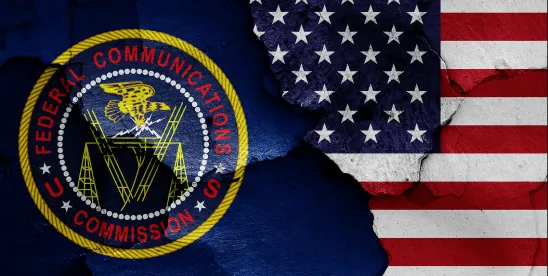The wireless industry has revolutionized the way we connect, from facilitating teleworking, distance learning, and telemedicine to allowing the American public to interact virtually in almost all other aspects of their daily lives. Leading policymakers – federal regulators and legislators – are making it a top priority to ensure that the wireless industry has the tools and resources it needs to keep pace with this evolving landscape. This blog provides monthly updates on actions by federal regulatory bodies responsible for communications policy and Congressional efforts to support wireless connectivity. And this month we highlight the FCC’s plans to open up spectrum for drones.
Regulatory Actions and Initiatives
Wireless Spectrum
The FCC Announces Plans to Make Spectrum Available for Drones. On April 8, 2024, the FCC issued a News Release announcing that FCC Chairwoman Rosenworcel circulated a Report and Order with proposed rules to enable wireless communications for uncrewed aircraft systems (“UAS”) – also known as drones – in the 5 GHz band. The FCC appears to envision use of the 5 GHz band by UAS operations through dynamic frequency management systems. Chairwoman Rosenworcel explained that: “The FCC must ensure that our spectrum rules meet the current – and future – spectrum needs of evolving technologies such as uncrewed aircraft systems, which can be critical to disaster recovery, first responder rescue efforts, and wildfire management.” The FCC has not yet released a copy of the Report and Order.
NTIA Provides an Update on its Implementation Plan for the National Spectrum Strategy. NTIA’s Charles Cooper posted a blog on the agency’s efforts related to the implementation of the National Spectrum Strategy. First, he notes that NTIA is targeting October for the distribution of Spectrum Relocation Fund funding for the federal agencies’ studies of the 3.1-3.45 GHz band (“Lower 3 GHz band”) and 7/8 GHz bands. The blog post outlines the process for obtaining funding and confirms that NTIA and DoD will co-lead the Lower 3 GHz band study, with NTIA and “affected Federal agencies” co-leading the 7/8 GHz band study. Second, the blog post notes that NTIA has begun work on dynamic spectrum sharing, although it admits that “updates may be far less frequent for the next few months.” Finally, the blog post explains that Derek Khlopin has overall responsibility for implementing the National Spectrum Strategy; Charles Cooper will lead the Lower 3 GHz efforts; the 7/8 GHz studies will be led by Scott Patrick; and Shiva Goel is the new Senior Advisory for spectrum.
The Department of Defense Releases its Lower 3 GHz Band Report. Following its announcement in September 2023, the Department of Defense (“DoD”) released a redacted version of its Report on the Lower 3 GHz band on April 3, 2024. The Report summarizes the DoD’s findings regarding use of the Lower 3 GHz band for commercial wireless operations and concludes that the spectrum, which is principally used by federal agencies, can be shared and used by non-federal entities only if certain conditions are met. The Report has been shared with NTIA, which will work with the FCC to determine which frequencies will be made available for commercial use as well as how and when that will occur.
The FCC Allows Additional Use of the 5.9 GHz Band for Connected Cars. The FCC’s Public Safety and Homeland Security Bureau, Office of Engineering and Technology, and Wireless Telecommunications Bureau (collectively, the “Bureaus”) released a letter granting 11 individual waiver requests submitted by (i) certain state, local, and municipal transportation authorities, (ii) Battelle Memorial Institute, a contractor for the Federal Railroad Administration, and (iii) several equipment manufacturers to deploy Cellular Vehicle-to-Everything (“C-V2X”) technologies, which can be used to support automotive safety, in the 5.9 GHz band. The Bureaus found that grant of the waivers would serve the public interest by encouraging widespread deployment of C-V2X technologies and imposed the same technical requirements and restrictions on the waiver applicants that were adopted in the Joint Waiver Order, as modified by the Joint Waiver Modification Order. The geographic areas of the waiversare limited to the areas encompassing the parties’ respective legal jurisdictions or the geographic parameters that will ultimately be defined by their licenses. The Bureaus reminded ITS licensees that they must register each roadside unit (“RSU”) in the FCC’s Universal Licensing System before operating the RSU.
The FCC Asks Whether to Make Additional 900 MHz Spectrum Available. The FCC’s Wireless Telecommunications Bureau (“WTB”) released a Public Notice on April 2, 2024, seeking comment on a Petition for Rulemaking that urged the FCC to expand opportunities for parties to deploy wireless broadband systems in the 900 MHz band (specifically, the 896-901 MHz and 935-940 MHz bands). The band has historically been used to support two-way voice and data communications networks for utilities, critical infrastructure, and business enterprise entities. This proceeding would make additional 5/5-megahertz spectrum channels available so that they can be used to support the growing demand for wide-area, private, and secure wireless broadband networks by those entities. Comments were due May 2, and reply comments are due May 18.
The FCC Reminds Tribal Entities of their Performance Requirements. The WTB released a Public Notice reminding holders of 2.5 GHz band Tribal licenses of their performance requirement deadlines. All new licensees in that band, including Tribal licensees, are subject to interim and final performance requirements within four and eight years, respectively, of initial license grant. The licensees must file notifications demonstrating completion of any related construction work by the applicable deadlines, many of which will occur in October 2024.
Wireless Networks and Infrastructure
The FCC Releases a Draft Item that Would Bar Entities of National Security Concern from Wireless Equipment Certification. On May 2, 2024, the FCC released a draft Notice of Proposed Rulemaking (“NPRM”) that would prohibit the FCC’s equipment authorization program from working with any lab or certification body with direct or indirect ownership or control by any entity on the “Covered List,” which includes, among others, Huawei. To implement the proposal, the FCC would propose a 10% ownership or control threshold and a 5% reporting threshold. Comments and reply comments on the NPRM would be due 60 and 90 days, respectively, after publication in the Federal Register. The FCC will vote on the NPRM at its open meeting on May 23.
The FCC Grants Additional Rip-and-Replace Extension Requests and Provides an Update to Congress. The FCC’s Wireline Competition Bureau (“WCB”) released a Public Notice on April 30, 2024 announcing that it has granted nine requests for extension of support recipients’ rip-and-replace deadlines. The grant of these requests continues to be based on funding and supply chain issues. Relatedly, on May 2, 2024, the FCC issued a News Release announcing that Chairwoman Rosenworcel sent a letter to Congress to provide the seventh update on the status of the Secure and Trusted Communications Networks Reimbursement Program and to emphasize the urgent need for additional funding. Among other things, Chairwoman Rosenworcel explained that Reimbursement Program participants now have rip-and-replace deadlines ranging from May 29, 2024, to February 4, 2025. And, to date, 64 extensions – 52 (or roughly 80%) of which have been “based in whole or in part on the funding shortfall” – have been granted by the WCB. In addition, the most recent status updates filed by Reimbursement Program participants demonstrate that a lack of full funding continues to be an obstacle for 64% of participants. In fact, almost 40% of participants reported that they could not meet their rip-and-replace obligations without additional government funding. Finally, the Chairwoman underscored that a failure to fully fund the Reimbursement Program could result in serious consequences for participants and their customers, potentially leaving them without a provider in their area, as well as raise legitimate national security concerns if the equipment remains in U.S. communications networks.
The FCC Announces Effective Date for Rules Facilitating Supplemental Coverage from Space. Through a notice published in the Federal Register on April 30, 2024, the FCC announced that the rules facilitating Supplemental Coverage from Space (“SCS”) will become effective on May 30, 2024. Comments and reply comments on the Further Notice of Proposed Rulemaking (“Further Notice”) released with the Order that seeks comment on whether the FCC should modify requirements for routing SCS 911 voice calls and text messages and on additional ways to improve the coexistence of radio astronomy and SCS are due May 30 and July 1, respectively.
The Government Accountability Office Reports on Permitting Delays. On April 10, 2024, the U.S. Government Accountability Office (“GAO”) released a Report on federal agencies’ performance in processing permitting applications for communications infrastructure. The GAO found that the Bureau of Land Management (“BLM”) and Forest Service process the most applications from telecommunications providers, but the agencies did not have sufficient data in most cases to track the extent to which they grant or deny applications within 270 days, which is required by statute. While the data they do have showed improvement in processing times, about half of the applications either exceeded the 270-day deadline or did not have sufficiently accurate and complete information to determine if they met the deadline. Accordingly, the GAO makes six recommendations (to which the BLM and Forest Service agreed) to improve the processing of communications use applications.
Wireless Services
The FCC Seeks Comment on the Impact of Connected Cars on Survivors of Domestic Violence. On April 8, 2024, the FCC released a Further Notice seeking comment on additional ways it can help survivors of domestic violence, particularly with respect to their use of wireless and connected car services. Among other things, the Further Notice asks for information about wireless service providers’ and auto manufacturers’ connected car service offerings. It also seeks comment on the steps they can proactively take to protect survivors from being stalked, harassed, intimidated, or otherwise revictimized through the misuse of connected car services. Comments and reply comments are due 30 days and 60 days, respectively, after the Further Notice is published in the Federal Register, which has not yet occurred. In a News Release accompanying the Further Notice, Chairwoman Rosenworcel commented: “No survivor of domestic violence and abuse should have to choose between giving up their car and allowing themselves to be stalked and harmed by those who can access its connectivity and data.”
Legislative Efforts
The Senate Introduces a Bill That Would Restore the FCC’s Auction Authority. On April 30, 2024, Senator Cantwell introduced the Spectrum and National Security Act of 2024. The bill, if enacted, would restore the FCC’s auction authority through September 30, 2029 and fully fund the rip-and-replace program with future auction revenue, among other things. The Senate’s markup of the bill was scheduled for May 1, 2024, but it was postponed because over 20 amendments to the bill have been filed.





 />i
/>i

